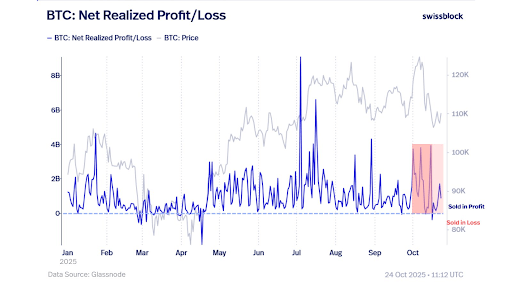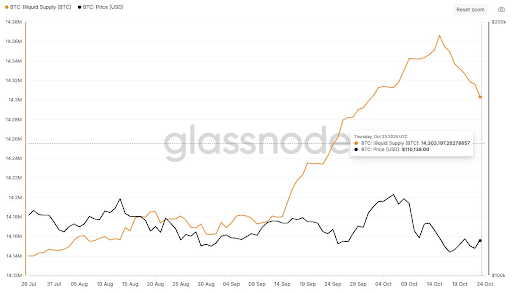Bitcoin remains stable in October 2025 despite increased selling pressure, declining profits, and a rise in coins entering circulation from long-term holders. This cautious market behavior reflects investor prudence amid economic uncertainties, with prices holding near $110,000 without signs of capitulation.
-
Bitcoin traders are selling more this month, but the market still looks calm with no major panic signs.
-
Profits have gone down as prices cooled, showing investors are being careful and locking in gains slowly.
-
Fewer long-term holders are keeping their coins, meaning more Bitcoin is now moving back into the market, with approximately 62,000 BTC shifting from inactive wallets.
Bitcoin stays steady in October 2025 amid rising selling, profit dips, and supply increases. Discover investor trends and market resilience in this detailed analysis. Stay informed on crypto dynamics today.
What is Bitcoin’s Market Behavior in October 2025?
Bitcoin’s market behavior in October 2025 demonstrates resilience amid heightened selling and profit-taking, with prices stabilizing around $110,000. Investors appear cautious, responding to economic indicators like upcoming inflation data, yet the absence of panic selling suggests underlying strength. Data from on-chain analytics highlights a balanced supply-demand dynamic despite these pressures.
How Are Profit and Loss Patterns Influencing Bitcoin Investors?
Profit and loss patterns in Bitcoin’s market reveal nuanced investor behavior throughout 2025. Early in the year, realized profits surged to nearly $4 billion between January and February as prices exceeded $100,000, according to Glassnode data analyzed by Swissblock. However, March saw a brief dominance of losses during a price correction, indicating profit realization amid volatility.
From April through June, sharp alternations between profits and losses underscored active trading during pullbacks, with losses occasionally surpassing gains. July marked a robust recovery, with realized profits climbing above $8 billion as Bitcoin approached yearly highs. This upward momentum persisted into August, though with diminishing fluctuations, pointing to maturing market participation.
By September and into October, profits notably declined as Bitcoin’s price retreated from $120,000 to around $100,000, entering a phase of net losses. This shift, visualized in Swissblock’s “BTC: Net Realized Profit/Loss” chart, shows traders selling below cost basis, yet overall activity remains subdued, avoiding extreme capitulation levels.

Source: Swissblock
The chart illustrates how these patterns foster a risk-off environment, with Swissblock noting the signal “ticking higher all week,” yet far from panic thresholds. This data-driven insight helps explain why Bitcoin’s stability persists, as investors methodically manage positions rather than reacting impulsively.
Illiquid Supply Trends and Their Impact on Bitcoin’s Price Stability
Bitcoin’s illiquid supply dynamics offer critical clues to its price stability in October 2025. Glassnode reports that illiquid supply—coins held in dormant wallets—rose from 14.12 million BTC in late July to 14.38 million BTC by early October, signaling accumulation during the summer rally. However, mid-October saw a reversal, with about 62,000 BTC exiting these wallets, increasing circulating supply.
This movement aligns with broader on-chain metrics, where declining illiquid supply can pressure prices by boosting available coins for trading without corresponding demand spikes. Despite this, Bitcoin’s price has held firm near $110,000, reflecting neutral sentiment and no aggressive selling waves. Swissblock’s analysis corroborates this, emphasizing that while supply easing introduces mild stress, the market’s resilience prevents downward spirals.

Source: Glassnode
Experts like those at Glassnode highlight that such adjustments are typical in mature cycles, where long-term holders gradually re-enter without disrupting equilibrium. This trend, combined with easing selling post-early October, underscores Bitcoin’s adaptive nature in navigating 2025’s economic landscape.
Frequently Asked Questions
What Factors Are Driving Increased Selling in Bitcoin During October 2025?
In October 2025, increased selling in Bitcoin stems from profit-taking after summer highs and caution ahead of inflation reports. On-chain data from Swissblock shows the risk-off signal rising, but selling volumes remain moderate, avoiding capitulation. Investors are strategically realizing gains, keeping the market composed despite higher activity levels.
How Does Declining Illiquid Supply Affect Bitcoin’s Future Price Trends?
Declining illiquid supply means more Bitcoin enters active circulation, potentially challenging upward price momentum without fresh buying interest. According to Glassnode, the recent 62,000 BTC outflow from dormant wallets could temper gains, yet current stability at $110,000 suggests balanced demand. For voice searches, this indicates a watchful but steady trajectory, with prices likely consolidating before major economic shifts.
Key Takeaways
- Market Resilience Amid Selling: Bitcoin’s stability in October 2025 highlights strong underlying support, as selling pressure eases without triggering panic.
- Profit Patterns Signal Caution: Declining realized profits reflect prudent investor actions, with net losses appearing briefly but not derailing the year’s gains.
- Supply Dynamics Offer Insight: The drop in illiquid supply to 14.38 million BTC encourages monitoring new demand; consider diversifying holdings for long-term security.
Conclusion
Bitcoin’s steady performance in October 2025, despite rising selling, profit dips, and illiquid supply adjustments, paints a picture of a maturing market. Insights from Swissblock and Glassnode data emphasize investor caution without alarm, positioning Bitcoin resiliently near $110,000. As economic data unfolds, staying attuned to these trends will guide informed decisions in the evolving crypto landscape.
